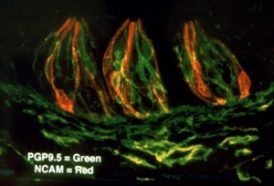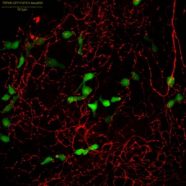Full-body taste
It was an heady day when Thomas Finger looked inner the nose of a small calamitous pussyfoot. Fingerbreadth had borrowed the animal from some other scientist. Information technology was not your average mouse.

The mouse's genes had been changed so that the taste buds on its knife turned green when you shined light along them — similar a secret subject matter written in secret ink.
But no one had ever looked inside its nose. When Finger finally did look there with a microscope, He sawing machine thousands of Green cells dotting the soft chromatic lining. "Information technology was like looking at little cat valium stars at night," says Finger, who is a neurobiologist at the Rocky Mountain Taste and Feel Center at the University of Colorado in Mile-High City. (A neurobiologist studies how the nervous system develops and functions.)
Seeing that green starlit sky was Finger's breadth's 1st glance of a new world. If he and else scientists are right, we don't sample things just on our tongues. Other parts of our body can likewise gustatory sensation things — our nose, our stomach, even our lungs!
You might take to be taste as something that you experience when you put coffee in your mouth — or chicken soup, or salinity. But for you to taste chocolate or chicken soup, specialised cells along your lingua have to tell the brain that they noticed chemicals that are in the food. We give birth at least five kinds of these chemical-detecting cells (commonly called taste cells) connected our tongues: cells that discover salt, sweet compounds, dark things, bitter things and savory things like meat surgery broth.
You might send for these five things the primary colors of your mouth. The unique taste of every food is made up of some combination of saltiness, sweet, vinegarish, resentful surgery Micromeria juliana, honourable as you can make any color of paint by mixing together bits of red, yellow and blueness.
It's these chemical-sensing cells that scientists are now finding all over the body.
"I'll bet you that in terms of tote up number of cells," says Finger, "there are more [taste cells] outdoor the mouth than inside the mouth."
This gives us clues about other functions the sense of taste has in our bodies. It could also help scientists obtain unexampled treatments for certain diseases.
Pisces the Fishes pare: many than a feeling
IT's an exciting time for scientists who study taste. Finger spent 30 years employed toward this big present moment. Both of the showtime clues came from fish.
Hindermost in the 1960s, scientists looking at fish skin under microscopes discovered that the outside of a Pisces the Fishes's slippery body is dotted with thousands of curious cells shaped like bowling pins. Those funny cells look just like the chemical-detection cells on your glossa. At the time, no one was sure what those bowling-pin cells on Pisces skin did. But years later, scientists found that they really can taste. When intellectual nourishment chemicals were sprinkled onto the fish skin, those cells sent a message to the angle brain — just same the cells on your tongue tell your brain when you gustation food.

For fish, organism able to sense of taste things all over their body comes in Handy. Few Fish called searobins use this to find their next meal. When searobins poke their pointy fins into the mud on the seafloor, they can "taste" the worms they're look to eat. Other fish called rocklings use these cells to sense the presence of big fish that might need to eat them.
In these cases, the buried worms and big shot leak out small amounts of chemicals into the water and mud. Taste cells on the pare of searobins and rocklings detect the chemicals (sort of the mode you mightiness be healthy to taste what's in the bathwater after your filthy little pal Saturday in the tub awhile).
As Finger designed searobins, goldfish and other wet critters, he began to question whether bring down animals like cats, mice and citizenry could also sense taste outside of their tongues. "Wherefore wouldn't it beryllium a good estimate?" he asks. "The more information you get from your environment, the better off you are."
Peeling mud
But finding taste cells on land animals wasn't easy. Unlike fishes', their hide is covered in a dry crust of dead cells, wish the layer of cracked mud that forms as a water relieve oneself dries. A taste cell hidden under that crust wouldn't function. It needs to come into reach with chemicals in the outside creation in order to detect them. So Finger decided to take the wetter, fishier parts of our torso. He started his research cryptical internal the poke.
That's when he borrowed the sneak out with the green appreciation buds — and saved those green, bowling pin-shaped cells inside its nose. The cells were scattered instead of organism clumped together, as they are in the clappe. But one thing was unquestionable: Those cells could gustatory sensation.
When Finger well-tried them, the cells restrained the same special proteins, called receptors, that your tongue uses to detect chemicals in food. Different kinds of receptors detect different kinds of chemicals — the likes of sugars, sour things and so on. Those in the mouse's nose specialistic in detecting bitter chemicals.
Since Digit's discovery of this in 2003, opposite scientists have found bitter-sensing taste cells in spite of appearanc the hundreds of ramification tunnels that motion ventilate through the lungs of animals.
Some scientists have also set up taste cells along the path that nutrient travels through and through a person's body — a journey of at least 12 hours. From the stomach, where food is first digested, those taste cells can be found all of the way to the large gut at the lower closing. Some in your bowel taste bitter things, others reconnoiter for sweet sugars.
(Non) savoring your stern
"There is an tremendous number of these cells in the lower bowel," notes Enrique Rozengurt, a biologist at UCLA (the University of CA campus in Los Angeles) whose team up first found sample cells in the gut in 2002. "Why fare you have all of these receptors?" asks Rozengurt. "There are both very profound possibilities."
It mightiness seem like a really regretful idea to have sample cells beyond the tongue. In your nose, wouldn't you taste salty buggers? And wouldn't you also taste the brown gooey gormandise in your large intestine — which is pretty much just poop waiting to be excreted? If we have taste cells inside our body, shouldn't we be taste nasty stuff daylong?
No, says Fingerbreadth. What you experience when your body "tastes" something depends on what start out of your brain the taste cells are lecture.
When you put a acerb pill in your mouth, the cells on your tongue talk to a region of your brain called the land cortex. This part of your brain is partly of your instant-to-moment thoughts. Information technology gets the message from your tongue — bitter! And yuck! Immediately, your face scrunches up. You want to spit the pill out.
Your inner worm
But when cells in the gut detect something bitter, they send on a little telegram to a deeper, older part of the brain. Scientists call information technology the core group of the solitary tract, but you might well think of it as your inner worm.
This part of the brain takes care of lanceolate things that a mindless worm would make out: pushing food through with the gut, digesting it and pooping it out. You Don River't have to think or so those things. They sensible happen.

When your mind's inner worm senses the arrival of something bitter in the intestines, IT tells your Einstein: Cease. You've eaten something bad. Get free of it — quickly! You may suddenly look sick, spue, or have diarrhea. And these things happen without any conscious decisionmaking happening your part.
The world is full of bad things like toxic plants and bad foods. These are things that acerbic-taste cells in your digestive system of rules sentinel for. Says Rozengurt, they "are at that place to defend the States against all of these harmful substances."
Bitter sternutation
Bitter-spying cells in your wind and lungs protect you in a similar way of the same agency. Bad bacterium sometimes enter your intrude or lungs.They cause infections that can make it hard to take a breather. Bitter-taste cells legal an internal alarm when they detect chemicals that the crappy bacteria squirt out.
That alarm signals your consistence to sneeze or cough up the bad stuff retired. Bitter-gustatory perceptio cells can also spark a process that tells white rakehell cells to attack the unwished-for germs.
It makes common sense that you'd want to vex rid of nasty, bitter-tasting gorge. Just your put u and intestines besides have cells that detect sweet sugars. And they send off out same different messages.
It's 1 thing to taste sugary pancakes and syrup in your mouth, but what about along the rest of the 30 feet that your breakfast travels through the venter and intestines?
Those other parts of your body also need to recognize when something perfumed has arrived, says Robert Margolskee of the Go up Sinai School of Music in New York Urban center. Cells scattered up and dispirited your gut human action as a tracking system to let your body know when the sugary food arrives at each location. "It starts things going further down in the organic process tract to digest those things," says Margolskee.
Scientists have some evidence that the gut also contains taste cells that notice meaningful, inoffensive chemicals. Like the sweet-taste cells, these probably besides watchful distinguishable parts of the catgut to what's climax.
Taste medicines
Margolskee Lententide Finger those green-tongued mice in 2001. In 2009, Margolskee observed that lucre-detective work cells of the intestine squirt out a messenger substance, called a hormone, that prepares the intestine to soak up sugars. Those hormones also let another theatrical role of the personify, called the pancreas, know that sugar is on its way. The pancreas oozes out its own endocrine — called insulin — that tells other parts of the body, from the muscles to the nous, to prepare for that sugar.
Making drugs that affect the gut's taste cells could help treat a common disease named diabetes. In diabetes, the eternal rest of the torso appears virtually deaf to the insulin substance that the pancreas sends outer. So the muscles and brain don't take in much of the sugar, a leading source of zip, from the blood. A dose that "turns finished the sound in these gut taste cells," says Margolskee, might help the gut and the pancreas Thomas More effectively shout away to the rest of the body that sugar is coming — and to bring ready.
Just about people have another problem called mucous colitis. Here, intellectual nourishment oozes through their intestines overly quickly operating theatre also slowly, causation tingling dealings jams. Drugs that tickle the bitter-detecting cells might help the gut get-up-and-go food through more quickly and swimmingly, reducing stomach aches.
Just this retiring November, scientists made a more surprising discovery: Resentful-tasting cells in the lungs might one day help doctors address a disease named asthma.
People with asthma have distract breathing because the airways in their lungs close up. Nowadays scientists have found that some bitter substances actually open those airways. And these substances cause it better than unmatchable medicine that doctors frequently manipulation to treat asthma.
It's was only the in style surprise. People who study taste outside the mouth expect more wish keep on coming.
Until recently, says Rozengurt, a creation of taste sensors existed "that we were vaguely evocative of, but we didn't have any clues of how to study. Now we do."

0 Response to "Full-body taste"
Post a Comment